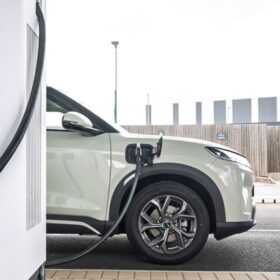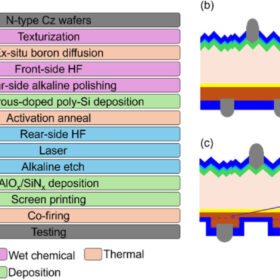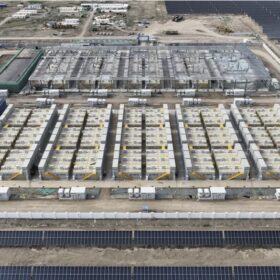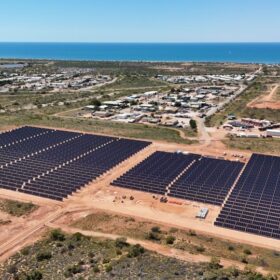Top News
NSW solar farms break 1 TWh generation barrier

Australia makes gains in electric vehicle uptake

Localised polysilicon thinning improves TOPCon solar cell performance
SunRise Arabia Clean Energy Conference 2026
Join the 3rd SunRise Arabia Clean Energy Conference on April 22, 2026, in Riyadh to explore how solar PV and energy storage are powering the Kingdom’s growing digital economy — including data centers. Secure your spot at the early-bird rate.
Battery Business & Development Forum 2026
Connect with Europe’s energy storage leaders at the Battery Business & Development Forum 2026 in Frankfurt (March 31–April 1) and gain insights into evolving business models, financing strategies, and market trends
Out now - pv magazine Global Winter Edition
The new pv magazine Global edition is out now!
Available in print and digital – get your copy today!

China connects world’s largest vanadium flow battery project

Pacific Energy advances plans to power remote WA town with renewables
UNSW research offers guidance for more robust TOPCon solar cells
Origin flicks operational switch on Australia’s biggest approved battery
Astronergy launches 670 W TOPCon solar module with 24.9% efficiency
Press Releases
Bluetti unveils Elite 320 rolling power station for affordable, essential home power backup
Astronergy launches ASTRO N7 Pro to unleash Pro performance
GoodWe receives EcoVadis gold medal, ranking top 5% companies
DON Smallgoods joins VPP to support energy transition and local community
Opinion & Analysis
Featured
Early forecast: First half 2026 solar outlook
Solar, wind and storage: stable prices, stable grid
The International Solar Energy Society explains how Australia’s rapid expansion of solar and wind energy has not increased wholesale electricity prices, which have remained stable since 2016. Rooftop solar, now widespread and highly cost-effective, provides the country with resilient, low-emission power, making all-electric homes increasingly independent from the grid.
Government pumps $5 billion into home battery program, issues persist
Over the weekend the federal government announced major changes to its $2.3 billion home battery subsidy program. The changes include nearly $5 billion in extra funding and adjustments to the financial support provided for different-sized batteries. They follow recent reporting that the program is subsidising unnecessarily large home batteries and blowing out in cost.
Post-COP30: Why distributed solar is becoming the world’s fastest-scaling power technology
Post-COP30 analysis has centred on the contentious debate over fossil-fuel phase-out wording. Yet the most significant development for the solar sector was not part of the negotiating text at all.
Household solar electricity generation in the Australian national accounts
The Australian electricity industry has transformed over the past two decades, driven by the rise of household solar and other renewable energy sources. Since 2010, supported by government incentives and improving technology, rooftop solar installations have surged.
Oversized batteries are blowing out Cheaper Home Batteries budget
The federal government’s $2.3 billion Cheaper Home Batteries Program is subsidising unnecessarily large energy storage systems and blowing out in cost.
Markets & Policy
Featured
Home battery uptake continues to climb
Pilot opts for hybrid project over standalone solar
Oil and gas explorer Pilot Energy has expanded its renewables ambitions, teaming with Hong Kong-headquartered SN Energy Group to jointly develop a hybrid solar and battery energy storage project on land in Western Australia previously earmarked for a 376 MW solar farm.
WA launches $9 million funding round open for clean energy projects
The Western Australian government has opened a new round of funding under its $37 million Clean Energy Future Fund with $9 million available to back “practical” clean energy projects that help diversify and decarbonise the state’s economy.
Bowen says renewables transition on track after 7 GW added to grid in 2025
Federal Energy Minister Chris Bowen insists Australia is on track to meet the government’s flagship target of 82% renewable energy by 2030 after solar, wind, and other renewables supplied about 50% of all power in the electricity grid in the final quarter of 2025.
Huawei, Sungrow lead Wood Mackenzie’s inverter market ranking
Wood Mackenzie’s first-half 2025 solar inverter ranking finds the top 10 leading inverter manufacturers have a 71% global market share.
China wafer leaders lift quotes as 2026 module prices may hit $0.21/W
China’s top wafer makers raised prices on key n-type formats, signaling potential module price rises toward $0.21 (CNY 1) per watt in 2026 amid efforts to curb loss-making competition.
Installations
Rooftop solar installs rise as households turn to bigger systems
Key transmission project reaches major construction milestone
Australia’s largest energy transmission project has reached a new milestone with the last of more than 1,500 steel towers constructed along the 700-kilometre New South Wales stretch of the EnergyConnect development that links the state’s energy grid with those in Victoria and South Australia.
China commissions world’s largest open-sea offshore solar project
China has brought a 1 GW offshore solar power plant online off the coast of Dongying, Shandong province, combining PV with energy storage and aquaculture in what is now the world’s largest open-sea solar project in commercial operation.
WA backs Traditional Owners’ 5 GW green energy parks target
The Western Australia government has committed $2.7 million to support a Traditional Owner group in its bid to develop solar and battery energy storage projects with up to 5 GW of capacity in the state’s Pilbara region.
BNEF flags potential global solar slowdown in 2026 as China cools
BloombergNEF projects a slight year-on-year dip in global solar additions in 2026 as China’s growth eases, even as installations elsewhere continue to rise.
Machine-learning models identify hidden physical defects in solar arrays
The software tool uses self-supervised learning to detect long-term defects in solar assets weeks or years before conventional inspections, potentially reducing operations and maintenance costs.
Technology
Rising silver prices drive China’s Longi shift to copper-metallised solar cells
New process achieves 97% silver recovery from end-of-life solar panels
University of Newcastle researchers have developed a new separation technique that employs the same crushing and flotation principles used in mineral processing to recover more than 97% of silver from end-of-life solar panels.
Trina Solar posts new milestones for tandem efficiency, module power
Trina Solar says new certified results in perovskite-crystalline silicon tandem cells and modules demonstrate progress toward industrial-scale next-generation PV.
Carmaker uses repurposed EV batteries to help power production plant
Repurposed electric vehicle batteries have been used for the energy storage component of a solar and battery project that is now helping power operations at carmaker Nissan Australia’s aluminium casting plant in Victoria
Neoen to tap new Telsa tech for South Australian battery project
Neoen Australia has launched construction of its third big battery in less than 90 days, helping accelerate the nation’s energy transition with 20 GW of utility scale solar, wind, gas, batteries and pumped hydro now either commissioning or under construction across the National Electricity Market.
Aiko achieves 24.8% efficiency in commercial solar module production
The result relates to the company’s Comet 3N modules and has been confirmed by independent testing agency TÜV Nord in Germany.
Manufacturing
Featured
Fox trots out stackable battery system for residential, commercial applications
Ambrion launches new all-in-one storage solutions
The Australian firm has introduced single-phase 5 kW and 6 kW AC output storage systems, as well as three-phase 10 kW and 12 kW models. Storage capacities of the new products range from 5 kWh to 40 kWh.
GoodWe launches new hybrid inverters for C&I solar
The Chinese manufacturer has launched a new series of three-phase hybrid inverters ranging from 80 kW to 100 kW. The new products feature eight MPPTs with up to 42 A input current.
All solar cell efficiencies at a glance – delayed
The research group led by Professor Martin Green has not published yet Version 67 of the solar cell efficiency tables, due to production delays. Green, however, has agreed to comment on some of the results to be added in the upcoming edition.
Researchers unmask fast charge potential of hard carbon anodes
Japanese researchers have found sodium-ion batteries using hard carbon anodes can intrinsically charge faster than lithium-ion batteries, challenging long-held assumptions in battery research.
EnergyConnect transmission project records 10 million worker hours
Transgrid and Elecnor Australia, construction partners on the $4.1 billion, 700 kilometre EnergyConnect transmission project have clocked more than 10 million worker hours on the epic project involving the construction of over 1,000 transmission towers.
Energy Storage
Featured
Flow Power reaches financial close on first standalone battery
Venergy completes 4.4 MW rooftop solar rollout for Stockland
Venergy Solar has completed what it says is one of the largest embedded network solar projects in Australia with 1,120 rooftop PV systems installed across four of property developer Stockland’s land-lease communities in Victoria.
Potentia pushes energisation button on solar-battery hybrid project
The first solar-battery hybrid facility approved in the National Electricity Market, the $190 million Quorn Park Solar Hybrid project developed by Potentia Energy in New South Wales, has been energised.
Facilitating DER/CER in Australia’s two-way energy system: report
The Australian Energy Regulator has released its third annual export services network performance report on facilitating consumer energy resources in Australia’s two-way energy system.
1 GW transfer capacity unlocked by existing Hunter region network upgrades
Electricity distributor Ausgrid will unlock 1 GW of transfer capacity from the Hunter-Central Coast Renewable Energy Zone by upgrading its existing distribution poles and wires, instead of building of building new ones.
Renewables remain lowest-cost option says CSIRO report
The national science agency’s latest update on the cost of meeting Australia’s future power needs has again found firmed renewables provide the lowest-cost option for electricity generation.




